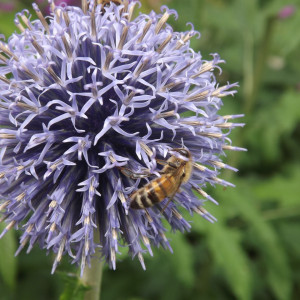Planting a Pollinator Garden in the Greenbelt/Treebelt/Verge
When we moved to the south end of Burlington in 2008, I dug up almost all the grass lawn in our yard—keeping only a ten-foot diameter section where we had lawn chairs—and replaced it with native plants and cultivars. Because I was concerned by the decline in numbers and health of pollinators like bees, butterflies, moths, and bats—especially with increased use of insecticides with neonicotinoids and herbicides like Roundup—I wanted to plant a pollinator garden. Most of our yard was very shady, with lots of hemlocks and white pines and a few white cedars. Just about the only place that had enough sunlight each day during the growing season to support pollinator plants was the greenbelt/treebelt/verge—the eight-foot wide strip of land between the street and the sidewalk which actually belongs to the city, but the nearby homeowner is expected to maintain. I checked with then-City Arborist to make certain it would be all right for me to replace the grass there with pollinator-friendly plants. He said I could do so as long as I did not plant marijuana and kept the area neat and tidy and did not have real tall plants like sunflowers that might lean or fall into the street or sidewalk. He also reminded me that there are usually lots of utility lines (electric, telephone, cable, gas, etc.) buried in the greenbelt, and I should contact Dig-Safe before doing any digging.
I carried out the conversion. The pollinator plants I used were mostly from divisions of plants I already had around the yard or ones I bought at plant sales. As you can see from the photographs, my favorites are: globe thistle (Echinops), beebalm/bergamot (Monarda), coneflower (Echinacea), black-eyed Susan (Rudbeckia), butterfly plant (Asclepias; native common milkweed can get a little messy for an urban garden, so I prefer the colorful cultivars), Phlox, cranesbill (Geranium), daylilies (Hemerocallis), sneezeweed (Hellenium), yarrow (Achillea), aster (Symphyotrichum), tickseed (Coreopsis), Joe Pye-weed (Eupatorium), anise hyssop (Agastache), spiderwort (Tradescantia), turtlehead (Chelone); and some larger butterfly bush (Buddleia), false indigo (Baptisia), and goatsbeard (Aruncus).
The garden met the criteria to be a “Wild for Pollinators” garden, so I registered it and received a sign, which I placed on the street side of the garden to help raise awareness of the importance of pollinators and encourage the creation of more pollinator and beneficial insect habitat across Vermont and in appreciation for the excellent resources that program offers.
Youth from several camps and daycare centers have come to see the garden and pollinators. One group, as part of a STEM unit on conducting a population census, used string to divide my main 100’ x 8’ garden into smaller sections, and then estimated 400 pollinators in the garden, including one hummingbird … and that was on an overcast afternoon. And we counted 22 pollinators—mostly tiny stingless bees, a few honeybees, two bumblebees, and a Monarch butterfly—on a single Echinops flower, their combined weight causing it to bend down.
I expect that most Extension Master Gardeners in Vermont have plenty of sunlight in their yards and do not live in urban areas with greenbelts, so can plant pollinator-friendly plants in numerous locations at their homes. And there are also other initiatives to plant pollinator-friendly plants in places besides greenbelts, such as between rows of solar panels in “solar orchards” and adjoining both entrances to covered bridges throughout Vermont.



















